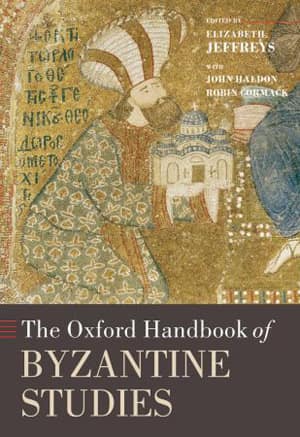1056 s, s/b resimler, sert kapak ciltli, şömizli, İngilizce.
The Oxford Handbook of Byzantine Studies presents discussions by leading experts on all significant aspects of this diverse and fast-growing field. Byzantine Studies deals with the history and culture of the Byzantine Empire, the eastern half of the Late Roman Empire, from the fourth to the fourteenth century. Its centre was the city formerly known as Byzantium, refounded as Constantinople in 324 CE, the present-day Istanbul. Under its emperors, patriarchs, and all-pervasive bureaucracy Byzantium developed a distinctive society: Greek in language, Roman in legal system, and Christian in religion. Byzantium's impact in the European Middle Ages is hard to over-estimate, as a bulwark against invaders, as a meeting-point for trade from Asia and the Mediterranean, as a guardian of the classical literary and artistic heritage, and as a creator of its own magnificent artistic style.
I. The Discipline
1: Byzantine Studies as an academic discipline
Elizabeth Jeffreys, Robin Cormack & John Haldon:
2: Instrumenta: tools for the study of the discipline
John Haldon: Primary sources
Anthony Bryer: Chronology and dating
Chris Entwistle: Weights and measures
James Crow: Archaeology
Leslie Brubaker: Critical approaches to art history
Kathleen Corrigan: Iconography
Panagiotis Agapitos: Literary criticism
Michael Jeffreys: Textual criticism
Erich Trapp: Lexicography and electronic textual resources
Hickey Todd: Palaeography, codicology, diplomatic
Andreas Muller: Documents: imperial chrysobulls
Rosemary Morris: Documents: Athos
Sally McKee: Documents: Venetian Crete
Cyril Mango: Epigraphy
John Nesbitt: Sigillography
Eurydike Georganteli: Numismatics
Dion Smythe: Prosopography
Peter Kuniholm: Dendrochronology
Jonathan Bardill: Brickstamps
Cecily Hennessy: Topography of Constantinople
II. The Physical World: Landscape, Land Use and the Environment
1: The political geography of the Byzantine world
Mark Whittow: Geographical survey
Geoffrey Greatrex, John Haldon,
Catherine Holmes & Angeliki Laiou: Political-historical survey
2: Communications (roads, bridges, etc.) Klaus Belke
3: Population, demography and disease Dionysios Stathakopoulos
4: Settlement
Helen Saradi: Towns and cities
Alan Harvey: Villages
5: Buildings and their decoration
Jonathan Bardill: Building materials
Robert Ousterhout: Churches and monasteries
Charalambos Bakirtzis: Secular and military buildings
Robin Cormack: Wallpaintings and mosaics
6: Production, manufacture and technology
Michael Decker: Agriculture and agricultural technology
Maria Parani: Fabrics and clothing
David Jacoby: Silk production
Pamela Armstrong: Ceramics
Marlia Mango: Metal work
Antony Cutler: Ivory, steatite, enamel, and glass
John Lowden: Book production
John Haldon: Military technology and warfare
John Pryor: Shipping and seafaring
Michael Decker: Everyday technologies
III. Institutions and Relationships
1: Hierarchies
Jeffrey Featherstone: Emperor and court
Jean-Claude Cheynet: Bureaucracy and aristocracies
Mary Cunningham: Clergy, monks, and laity
2: The State
John Haldon: Structures and administration
John Haldon: Army
Wolfram Brandes & John Haldon: Revenues and expenditure
3: The Church
Michael Angold and Michael Whitby: Structures and administration
Clarence Gallagher: Councils
Clarence Gallagher: The Two Churches
Robert Taft: Liturgy
John McGuckin: Monasticism and monasteries
Timothy Miller: Charitable institutions
4: The economy Alan Harvey
5: Society
Liz James: Role of women
Ruth Macrides: Families and kinship
Gunther Prinzing: Patronage and retinues
Anthony Bryer: Food, wine, and feasting
Charlotte Roueche: Entertainment, theatre and hippodrome
Peregrine Hordern: Hospitals and hygiene
6: Justice: legal literature Bernard Stolte
7: The spiritual world
Andrew Louth: Byzantine theology
Dominic O'Meara & Katerina Hieradiakonou: Philosophies
8: The symbolic world
Henry Maguire: Art and text
Nancy Sevcenko: Art and liturgy
Jas Elsner: Art and pilgrimage
Robin Cormack: Art and iconoclasm
Maria Vassilaki: Icons
Antony Eastmond: Art and the periphery
9: Language, education and literacy
Geoffrey Horrocks: Language
Athanasios Markopoulos: Education
Michael Jeffreys: Literacy
Anne Tihon: Numeracy and science
Nigel Wilson: Libraries
10: Literature
Elizabeth Jeffreys: Rhetoric
Michael Whitby & Michael Angold: Historiography
Andrew Louth: Theology
Alice-Mary Talbot: Hagiography
Mary Cunningham: Homilies
Margaret Mullett: Epistolography
Wolfram Horander: Poetry and romances
Eric McGeer: Military texts
11: Music Alexander Lingas
IV. The World around Byzantium
1: Byzantium and its neighbours James Howard-Johnston
2: Byzantium's role in world history Cyril Mango
Lists of rulers, patriarchs and popes




